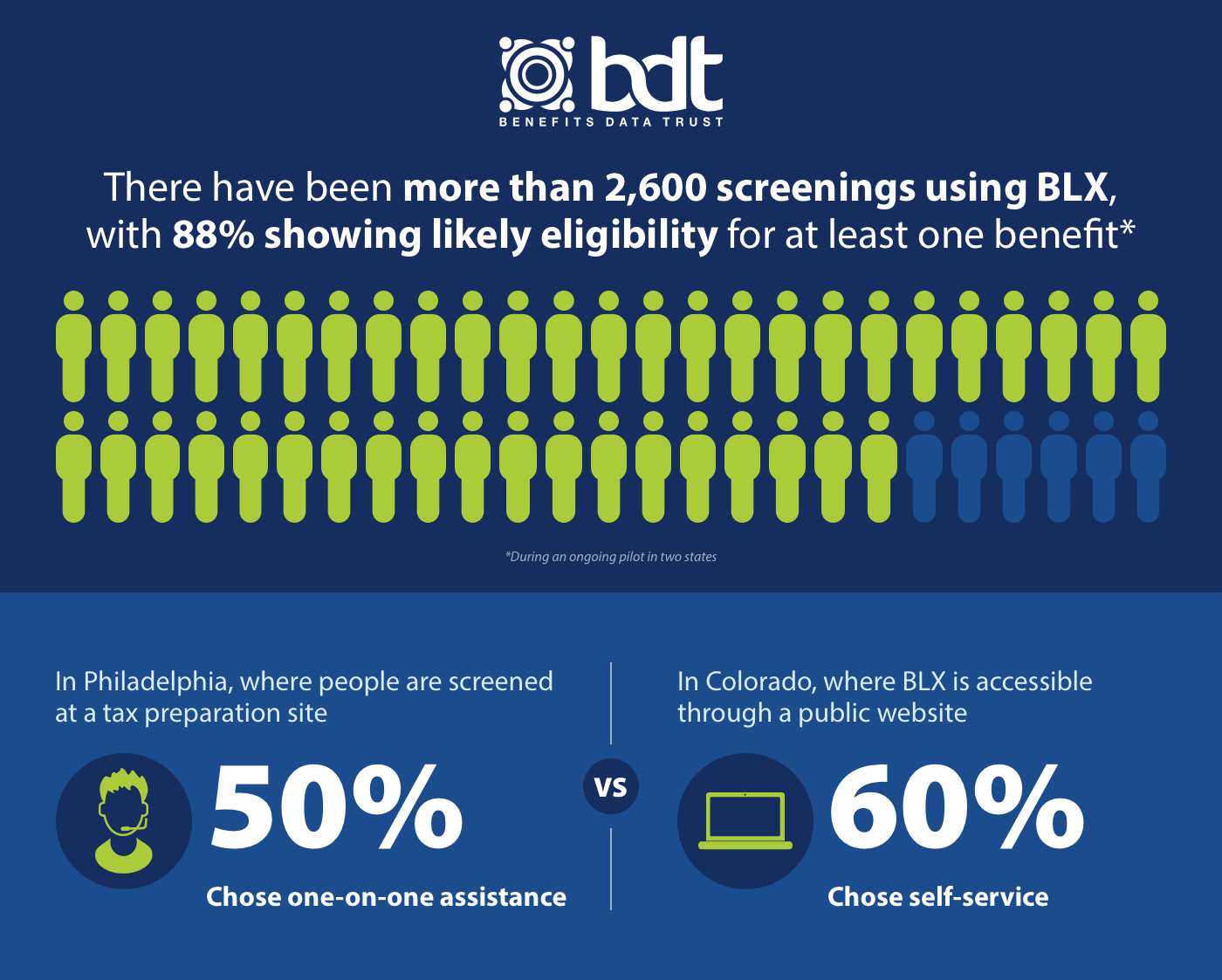Especially during a time when so many are struggling to put food on the table or pay their bills, it should be easy to access benefits. Unfortunately, since benefit programs are often housed in different government agencies, each with its own application process, it can be challenging to know where to start. Many have tried to solve this problem through online screeners that quickly help individuals to determine what they might be eligible to receive and then offer brief instructions about how to apply for each benefit. But what happens when people need more than information to successfully enroll?
At Benefits Data Trust (BDT), we wondered if it was possible to go beyond just screening for public benefits – could we also connect people to the application process that is right for them? Many find benefits applications to be challenging to understand and hard to navigate, which is why potential applicants could significantly benefit from direct assistance to complete the process in the ways that work best for their needs, whether that be in person, over the phone, or online from the comfort of their own home. So, we asked the question: Can we design easy pathways to assistance, based on personal preference?
Over the past 18 months, we used human-centered design to explore possibilities and inform pilots. The first step was to gather insights directly from the people we serve, as well as others in the community who provide benefits assistance. We focused on two very different geographies where BDT provides direct application assistance – Philadelphia and Colorado – and engaged people of all ages by conducting interviews, focus groups, and user testing.
The result was a working prototype called Benefits Launch Express (BLX), a free tool accessible by computer, phone, or tablet that estimates benefit eligibility and then prompts people to select their preferred application pathway: do-it-yourself online; get help over the phone through BDT’s contact center; or apply in-person at a partner organization. BLX then generates a step-by-step checklist to make the process as easy as possible and provides ongoing support through text reminders. The process is quick and user-friendly, taking less than 10 minutes, depending on the number of benefits.
With an early iteration of BLX ready to go, we designed two different pilots in each state that are still active today. In Philadelphia, BLX is available online and allows people to screen themselves for up to 19 different benefits. The original pilot was done in partnership with Campaign for Working Families (CWF), an organization which coordinated free tax preparation sites, where in-person assistance to complete the application process was immediately available (temporarily suspended due to COVID-19). In Colorado, BLX is publicly available online and screens for SNAP. To raise awareness about the BLX tool, BDT generates and sends text messages to potentially eligible people, in addition to our community partners engaging in direct outreach.
Since launching these pilots in Philadelphia and Colorado in 2019, BLX has generated more than 2,600 screenings, with 88% showing likely eligibility for at least one benefit. In Philadelphia, 50% have chosen hands-on assistance, either in-person or by phone. In Colorado, 60% have chosen self-service. These initial data sets suggest that BLX can be effectively utilized by specific populations with different preferences, but do people complete the process?
While there is an option to leave a phone number to receive follow-up notifications, BDT prioritized accessibility with BLX, and does not require individuals to provide identifying information to BDT. This choice makes it more difficult to find out whether people can successfully complete the application process. Around 30% of all people who complete a screening leave their phone number to receive follow-up notifications, and a few have responded to our texts to share where they are in the application process. While we are working to improve our understanding of the outcomes, the initial data are promising. For example, during the 2018 tax season, of the roughly 600 people screened on site for benefits using BLX and other BDT tools, 60% completed at least one application through in-person or phone assistance, suggesting that many people followed through, especially when the next steps were readily available.

So, what comes next?
BDT is engaged in research to create different versions of BLX to test best practices of how to connect people to their preferred path and how to secure the best outcomes. We are working to understand who prefers to self-serve and what light support they need to complete the process. We also want to improve connections between BLX and community supports, especially since many of our partners are now working remotely. The more testing, the more learning, and the more implementation we accomplish, the more people in need get valuable benefits to help them pay for food, housing, healthcare, and more, to improve their health, their lives, and their communities – a benefit to us all.
Thank you to the partners who helped BDT launch these pilots, including Campaign for Working Families, the Colorado Health Foundation, NextFifty Initiative, and United Way of Greater Philadelphia and Southern New Jersey. With their support, we’ll continue to expand and transform public benefits using data and technology, in order to better meet people where they are.
If you’re a community organization in Colorado or Philadelphia and would like to learn more about how Benefits Launch Express could help your community, reach out to us at partnerships@bdtrust.org.
